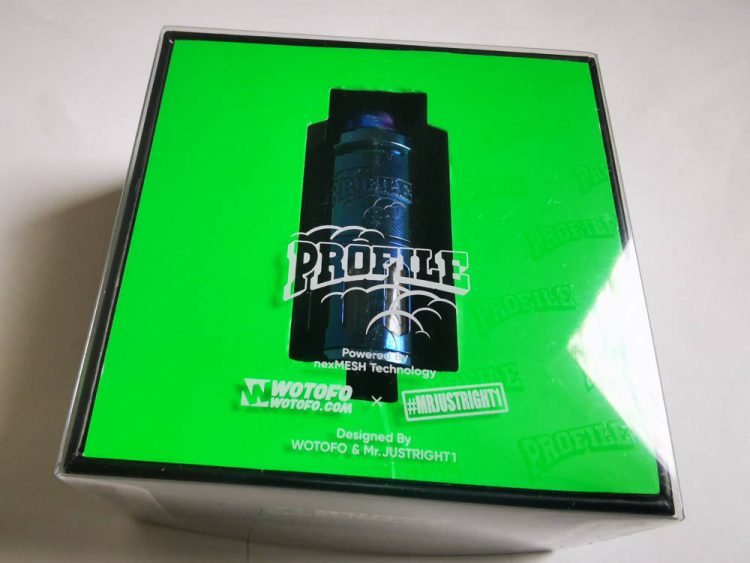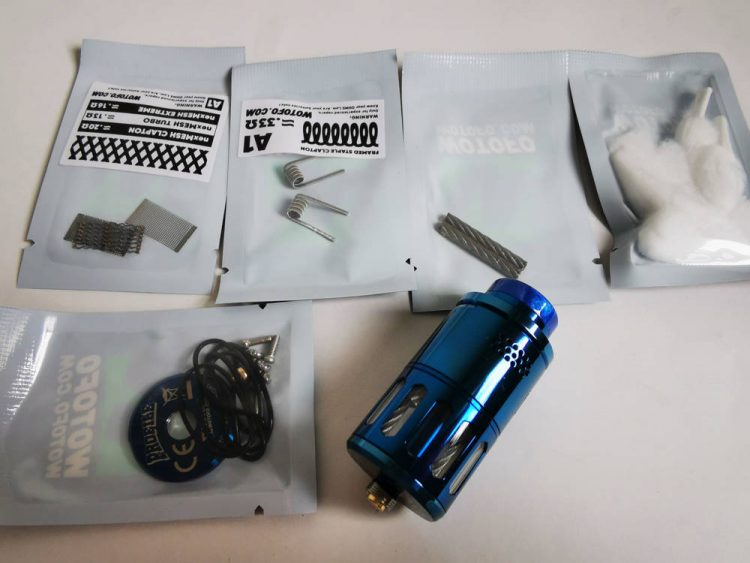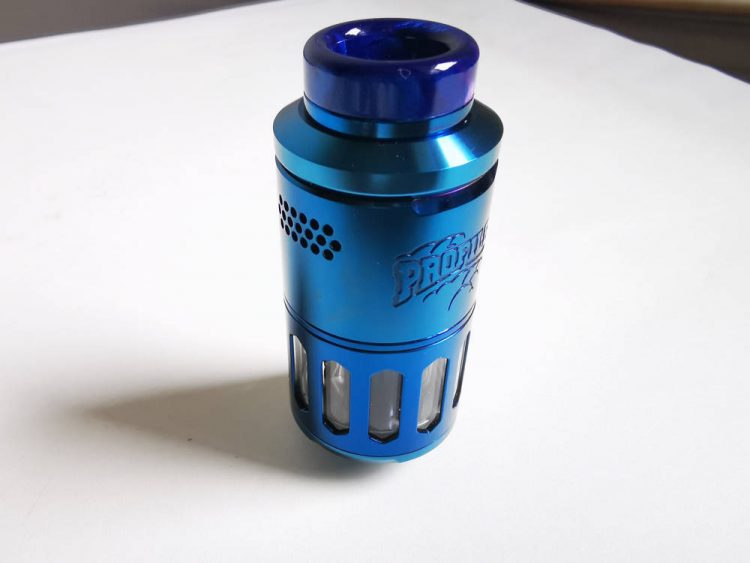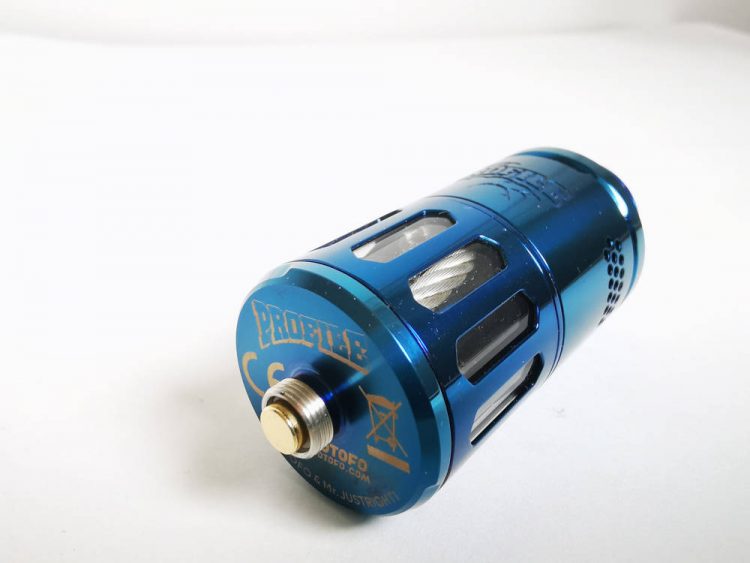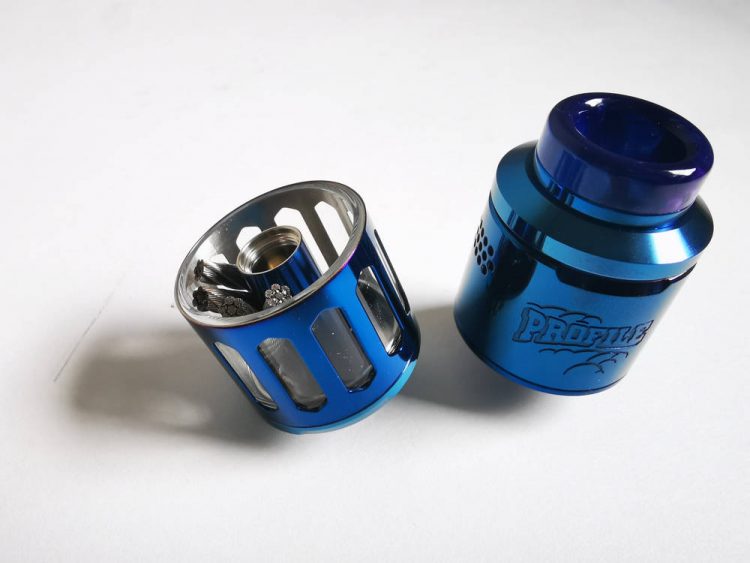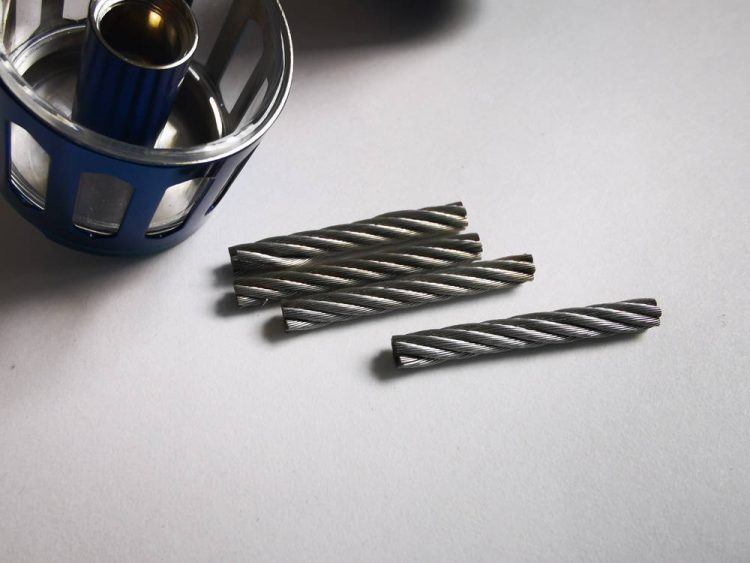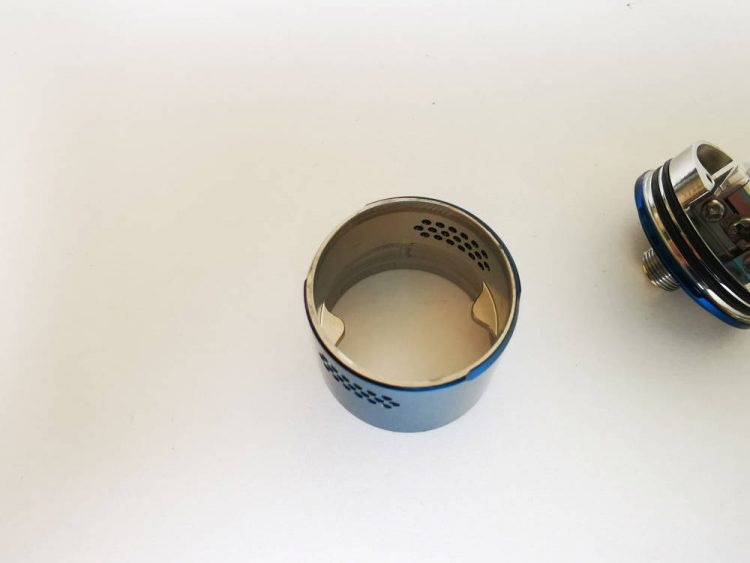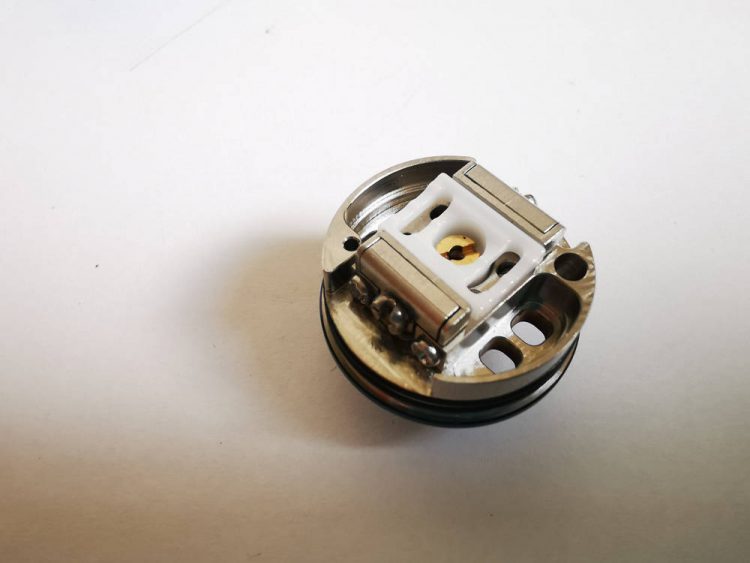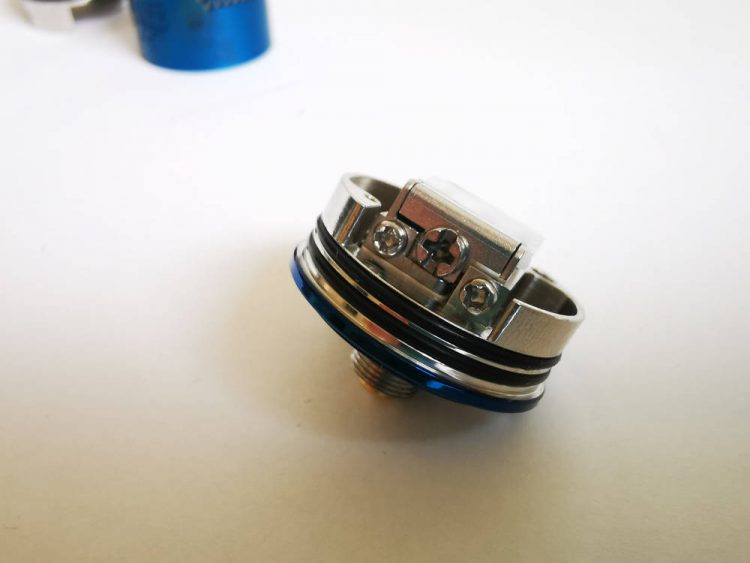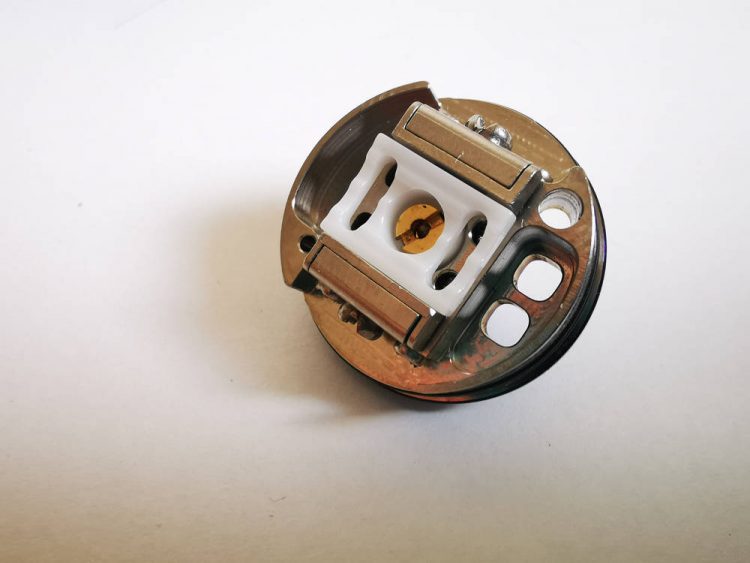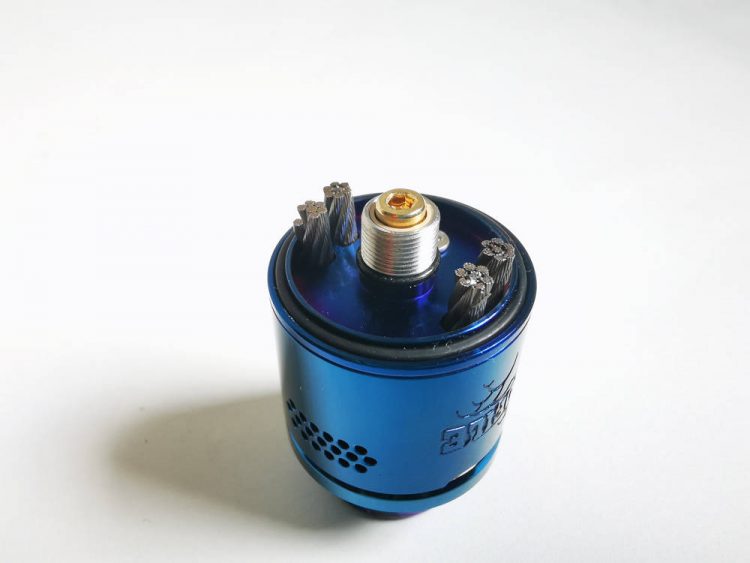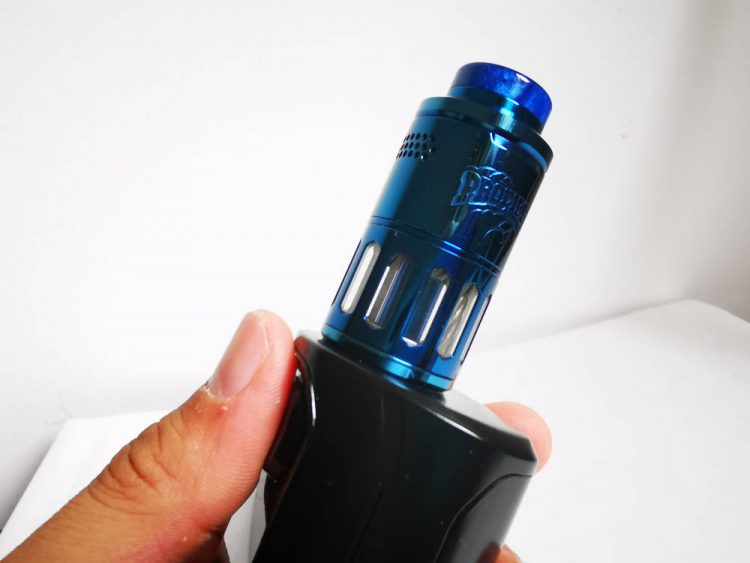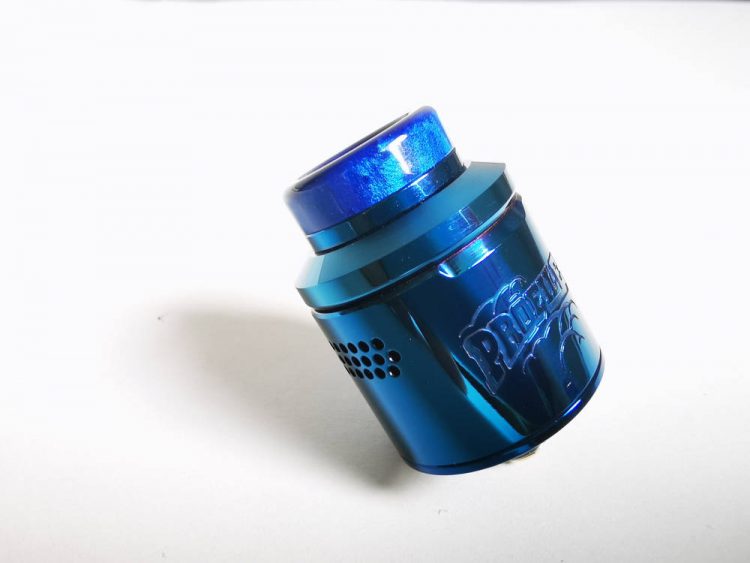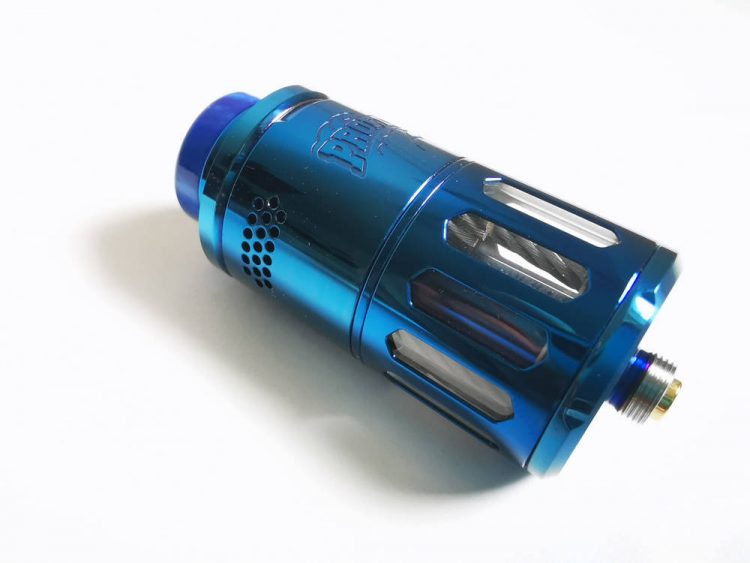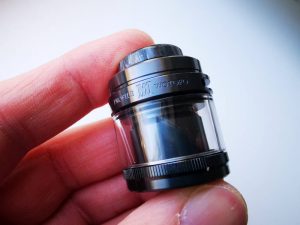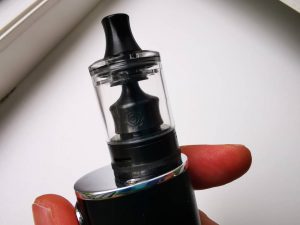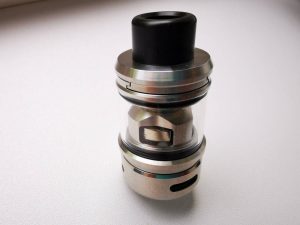Wotofo Profile RDTA Review
I think it’s safe to say that the Wotofo Profile RDA was revolutionary in terms of mesh coil installation, so it made sense for the Chinese manufacturer to keep the Profile brand alive, but at the same time it had to make sure any new product would live up to expectations. Partnering with YouTube vape reviewer MrJustRight1, Wotofo recently revealed the new Profile RDTA it claims stands out thanks to its versatility and excellent performance. Let’s check it out:
Profile RDTA Packaging and Presentation
The Wotofo Profile RDTA comes in a small cardboard box with a transparent plastic lid that offers a clear view of the atomizer inside. Take off the lid and the Styrofoam holder that the Profile RDTA comes in and you’ll find one of the most generous collection of accessories ever put together for an atomizer kit.
This kit includes everything you need to start vaping (except e-liquid) and then some. You get a couple of framed stapled clapton coils, three different strips of mesh, four shoelace-style strips of cotton, a couple of stainless steel rope pieces for e-liquid transfer, a bag of spare o-rings, screws, a solid 510 pin and an RDA base, two different screwdrivers and a mesh bending tool. Anything you need, this kit has it.
The only thing I was disappointed by was the manual, if you can even call it that. As complex as the Wotofo Profile RDTA is, you’d think it had a whole book explaining everything, but the kit only includes a hilarious leaflet. Experienced vapers will figure everything out themselves, but if you haven’t used steel e-liquid transfer ropes before, you’ll find yourself a bit confused.
Profile RDTA Design and Build Quality
The first thing you’re probably going to notice about the Profile RDTA is how tall it is compared to most atomizers. It’s just under 53mm tall, 25mm in diameter, and can hold up to 6.2ml of e-liquid. It’s really tall, even for an RDTA, reminding of the towering behemoths of old, like the GeekVape Griffin 25.
The Profile RDTA is made primarily of stainless steel, and comes in a variety of colors, including black, gunmetal, blue or rainbow. The review sample I received features a glass tank, but as far as I understand, the commercial version will feature a tube made of some sort of Plexiglas-like material.
From the outside, the top half of the Profile RDTA is reminiscent of the original Profile RDA. The 810 resin drip tip is pretty much identical, as are the design of the top cap and the airflow slots drilled into the barrel. The only thing setting it apart is the tank portion underneath. Luckily, you can take the top half apart, attach the included RDA base accessory to the bottom of the build deck, and voila, you have yourself a Profile RDA 2.0. That’s one of the coolest things about this product, it’s basically a 2 in 1.
The bottom half of the Wotofo Profile RDTA has an interesting cage-like design, with a protective metal sleeve around the glass tank, but large enough cutouts to clearly see the e-liquid level inside. The risk of accidentally cracking the glass tank is minimal, which, I assume, is why they didn’t bother including a spare.
Screwing apart the RDTA, you’ll notice something peculiar about the inside of the tank section. It includes four pieces of stainless steel rope. These go in through the four slots drilled through the bottom of the Profile RDTA build deck and reach all the way to the bottom of the tank. What are they for, you ask? Well, they are meant to transfer juice from the tank to the cotton wick above.
These e-liquid transfer rope pieces basically rely on capillary action to feed e-liquid from the tank upwards into the atomization chamber. the Profile RDTA isn’t the first atomizer to use such a system, but it’s certainly the first one I’ve ever used, and I’m not completely sold on the idea. For one, these four pieces of metal add weight to an already hefty atomizer, so that’s a con, plus I don’t think they are very good at feeding juice to the cotton wick as fast as I need them to. Personally, I prefer to simply flip the RDTA upside down for about a second to make sure enough juice reaches the cotton.
But the things I dislike most about this system is that because each rope is made up of dozens of thin strands of wire, they will start to come undone. The holes that these ropes go into aren’t exactly cut to measure, and if you apply the slightest bit of pressure when inserting one of these things, chances are some of these wires will come undone. It’s easy to just bend them back into shape at first, but as more and more come undone, you will eventually have to replace the ropes. Luckily, the kit comes with two spares, so you should be fine for a while.
I’m not against this new wicking system with the metal rope pieces, I just don’t think it’s more efficient than having cotton leads reach into the tank. Companies claim that the rope pieces are great for feeding every last drop of e-liquid from the bottom of the tank to the cotton wick, which may very well be true, but generally speaking, I would rather top off the juice more often than use them. They are just more things to clean and keep an eye on when switching e-liquid.
The top cap of the new Profile RDTA is very similar to the one of the original Profile, with those notches that first cover up the airflow slots on the first row ,and then gradually plug up the ones on the other two rows as well. It works well, the o-ring has just the right tolerance to ensure that the airflow settings don’t change accidentally.
The barrel section of the RDTA is very similar to that of the original Profile as well, only this time around it features these metallic lips opposite each other on the inside. I didn’t understand what they were for at first, but after assembling the RDA section I realized they were designed to cover up the fill slot and the air release slot on the build deck. It’s an ingenious design, but one that I don’t think works as well as Wotofo and MrJustRight1 intended, as metal on metal doesn’t really stop liquids from leaking.
Speaking of leaking, e-liquid gushes out of this thing when it’s not vertical, so if you plan on carrying it in a bag, or a loose pocket, be very,very careful, because the risk of finding it in a pool of juice is very high. Sadly, the only way to prevent this is to either hold it vertically all the time, or remove the juice before placing it any other way than upright. This is true of most RDTA, so it’s not necessarily a defect of the Profile RDTA, but rather the nature of the beast.
Wotofo Profile RDTA Build Deck
The thing that really sets the Profile RDTA apart from similar atomizers is its versatility. The original Profile was by definition a mesh RDA, although you could use with a single round wire coil as well. Its successor, however, works just as well with several types of mesh strips, but also with regular coils, in single or dual-coil configuration, and that’s primarily thanks to a very ingenious build deck.
The design is considerably different than that of the original Profile deck. It still uses a clamp system, only this time each clamp features three screws, a large center one for mesh, and two smaller ones on the sides to tighten the leads of regular coils.
The ceramic center tray on which the cotton wicking rests in mesh coil mode is spring-loaded and features these cutouts in which the leads of regular coils can be inserted. It’s a really intuitive design that most vapers with a bit of coil installation experience will figure out in no time.
The wicking slots are just large and deep enough for a 25mm atomizer and feature four wicking slots – two on each side. Traditionally, that’s where you would insert your cotton leads, but in this case, that’s where those steel ropes go, so all you have to do is position the cotton over those holes and the capillary action will ensure it stays saturated. As I said above, I am not completely satisfied with this system, so I prefer turning the RDTA on its head for a second, to make sure enough juice reaches the cotton wick.
If you’re wondering what those two holes diagonally across from each other are for, the large one is the fill port, and the little one is to let the air out of the tank as you fill it. The fill port is a little tight, to be honest, but it should fit most needle top bottles.
How Does the Profile RDTA Vape?
That’s a tough question to answer, because this being a fairly advanced atomizer, there are a lot of things that can go wrong, from the installation of the coils or mesh strip, to the cotton wicking. Basically, what I am trying to say is that this device vapes as well as it’s set up. Also you get a certain vaping experience when you use the Profile RDTA in single coil mode and a different one entirely when you use a mesh strip. I recommend the latter.
The moment I opened the Profile RDTA kit and went through its content, I was curious about a certain type of mesh included. It’s that “mesh clapton” that everyone is talking about these days, so that’s the one I ended up installing. A closer examination of this coil revealed that it’s actually not real mesh, but several strands of clapton wire welded to three metal leads for support. Still, it was worth trying.
Having been using this mesh clapton for over a week now, there are couple of things I am a bit worried about. The first concerns the risk of the clapton wires detaching from those metallic strips they are welded to. It didn’t happen when I bent the mesh on the included tool to prepare it for installation, but who knows what may happen after extended use?
My second concern is the safety of vaping on a coil that was welded or, even worse, soldered? Is that ok? What materials were used, and is exposing them to high temperatures going to release anything dangerous in the vapor? This is a new type of coils, so there are some things that needs to be cleared up, that’s all I’m trying to say.
Performance-wise, I can’t fault either the mesh clapton strip or the Profile RDTA. If you do everything right (coil installation, wicking and power adjustment), both the flavor and vapor production should be nothing short of outstanding. Granted, it goes through juice pretty fast, but that is to expected when using mesh, because the contact surface of the coil is larger and juice vaporizes faster. That said, the flavor alone is worth it.
The mesh clapton isn’t the only one responsible for the excellent performance. The airflow system should receive some praise as well, in my opinion. It’s not a perfect design, but the honeycomb slot system works very well in my opinion, and gives the user very good control over the amount of air that reaches the coil.
Unfortunately, I never had a chance to try the original Wotofo Profile RDA, but it was anything like this RDTA in terms of mesh vaping performance, I can understand why it is still regarded as one of the best mesh atomizers ever.
Conclusion
The Wotofo Profile RDTA is an impressive and versatile vaping device, the kind we don’t see a lot of these days. RDTAs in general are incredibly rare, so to see a really well thought out one that comes with the bonus of transforming into a Profile RDA 2.0 is a real treat. There were some things I wasn’t a big fan of, like its height in RDTA mode, and the metallic rope wicking system, but I have to admit that when it came to performance, I was very impressed.
If you liked the Profile RDA in mesh coil mode, you’re probably going to love the RDTA version, as it improves on the original design in every way.
The Wotofo Profile RDTA was sent to me directly by Wotofo for the purpose of this review.
Pros
- improved build deck
- great e-liquid capacity (6.2 ml)
- RDA mode
- excellent performance
Cons
- too tall
- leak-prone (when tilted)
- those stainless steel ropes

